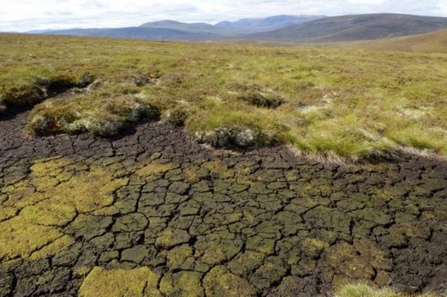The end of January saw the long awaited, formal inclusion of peatlands in the UK GHG emissions inventory.
Peatland addition to the UK GHG inventory adds 3.5% to national emissions

Bare peat pan. Credit Lorne Gill / NatureScot
Department for Business, Energy and Industrial Strategy (BEIS) released ‘Planned methodology changes for UK greenhouse gas emissions statistics 1990-2019’. The report summarises that inclusion of new peatland data increases their contribution to national emissions to 3.5% (as opposed to 2.3% reported in the 1990 baseline).

Table - Peatlands added to GHG inventory.
The methodology applied is based on the “Implementation of an Emission Inventory for UK Peatlands” (Evans et al. 2017). Emission factors presented in that report have been updated with additional greenhouse gas flux measurements published since 2017 and further refinements made to other assumptions, including on area changes, especially peatland restoration, following further review.
December 2020 saw the release of the Climate Change Committee's Sixth Carbon Budget: the Budget required under the Climate Change Act, provides ministers with advice on the volume of greenhouse gases the UK can emit during the period 2033-2037. To begin to tackle these increased emissions figures within the UK Inventory, the Climate Change Committee set out a recommended pathway for peatlands contribution to a Balanced Net Zero Pathway for the UK:
- Peatland restoration increases the UK area restored from 25% currently to 58% in 2035 and 79% by 2050, with a further 35% of lowland cropland sustainably managed.
- All upland peat is restored by 2045 (or stabilised if degradation is too severe to restore to halt carbon losses).
- 25% of the area of lowland grassland is rewetted by 2035, rising to half by 2050.
- 75% of lowland cropland is either rewetted or sustainably managed by 2050:
- A quarter of the area is rewetted to near natural condition (and crop production ceases), and a further 15% is rewetted but conventional crop production switches to paludiculture crops.
- Water-table management options are deployed to 35% of the lowland cropland area.
- All low-productive trees of less than YC8 are removed off peatland by 2030 and all peat extraction sites are restored by 2035.
- The above measures deliver annual abatement savings of nearly 6 MtCO2e by 2035 and around 10 MCO2e by 2050.
- Current UK peatland emissions are put at 24.5 MtCO2e (we are using Global Warming Potential AR5 for all our results).
- Policy recommendations from the January land use report remain valid (e.g. immediate end to rotational burning of peat, end the sale of peat for use in the horticulture sector)
